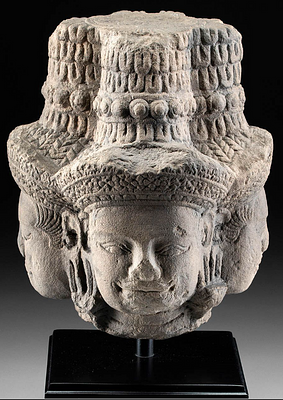Rare Haida Bead Necklace + Wood Soul Catcher Pendant
About Seller
686 S Taylor Ave, Ste 106
Louisville, CO 80027
United States
Selling antiquities, ancient and ethnographic art online since 1993, Artemis Gallery specializes in Classical Antiquities (Egyptian, Greek, Roman, Near Eastern), Asian, Pre-Columbian, African / Tribal / Oceanographic art. Our extensive inventory includes pottery, stone, metal, wood, glass and textil...Read more
Two ways to bid:
- Leave a max absentee bid and the platform will bid on your behalf up to your maximum bid during the live auction.
- Bid live during the auction and your bids will be submitted real-time to the auctioneer.
Bid Increments
| Price | Bid Increment |
|---|---|
| $0 | $25 |
| $300 | $50 |
| $1,000 | $100 |
| $2,000 | $250 |
| $5,000 | $500 |
| $10,000 | $1,000 |
| $20,000 | $2,500 |
| $50,000 | $5,000 |
| $100,000 | $10,000 |
| $200,000 | $20,000 |
About Auction
Jun 29, 2023
Artemis Fine Arts info@artemisgallery.com
- Lot Description
Native American, Pacific Northwest Coast, United States, Tsimshian, Haida, or Tlingit, ca. early to mid-20th century CE. An incredible necklace of red wood disc beads, pine nuts, and cobalt glass beads- at the center is a wood soul catcher pendant inlaid with abalone shells. This is a very important pendant, in a stylized, tubular form of 2 zoomorphic heads facing opposite directions, incised with formline motifs and nacre shell inlaid as the bared teeth. The mouths here are covered with abalone, and it is unclear if the interior is hollow or filled. Soul catchers were worn by shaman and used to cure ill patients and became emblems of health and wellbeing – it is possible this example was purely symbolic. The necklace is displayed in a modern display case, the magnetic glass door front opens on hinge. case: 13.125" L x 2.75" W x 17.125" H (33.3 cm x 7 cm x 43.5 cm) 4.25" L x 1.25" W (10.8 cm x 3.2 cm)
Sickness and disease were often attributed to spirit possession; thus, the shaman would travel to the spirit world to recover a patient's "lost soul" and employ the soul catcher to contain the soul by plugging the hollow sculpture with wads of shredded cedar bark or other materials. The shaman would then return the soul to its rightful owner in the living world. Malevolent spirits could also be contained in these pendants - shamans would exorcise them from afflicted patients and catch the evil within these soul catchers. It is unclear what happened to these evil spirits and containers - were these permanently encased and not intended to be released?
The glass trade beads that Europeans introduced were highly coveted by Native tribes, and blue was the most prized color of all. In the Chinook Jargon, a trade language used amongst neighboring tribes, there was a specific name for blue beads to convey their importance, and today they are often known as "chief beads," and these often came from Russian fur traders. Before the introduction of glass, pine nuts were often drilled and worn as beads- the tree’s nuts and pitch both had medicinal purposes. The necklace is comprised of 2 cotton thread strands - seed beads and alternating pine nuts, wood, and glass, with a larger spherical blue bead tied above the soul catcher. An iron wire loop for suspension was set into the center of the wood and has oxidation from age and exposure.
Provenance: private West Jordon, Utah, USA collection, acquired in October 2012; ex-private Winslow collection, Albuquerque, New Mexico, USA, owned for over 15 years
All items legal to buy/sell under U.S. Statute covering cultural patrimony Code 2600, CHAPTER 14, and are guaranteed to be as described or your money back.
A Certificate of Authenticity will accompany all winning bids.
We ship worldwide and handle all shipping in-house for your convenience.
#178494Condition
Stringing threads are delicate and should not be handled regularly. Mineral and earthen deposits on beads. Missing a few abalone inlays to center of pendant. Stable pressure fissures to wood and russet patina to the iron bail loop. Displayed in modern case, front door panel is opens on hinge and has a magnet catch.
- Shipping Info
-
All shipping is handled in-house for your convenience. Your invoice from Artemis Gallery will include shipping calculation instructions. If in doubt, please inquire BEFORE bidding for estimated shipping costs for individual items.
-
- Buyer's Premium



 EUR
EUR CAD
CAD AUD
AUD GBP
GBP MXN
MXN HKD
HKD CNY
CNY MYR
MYR SEK
SEK SGD
SGD CHF
CHF THB
THB















